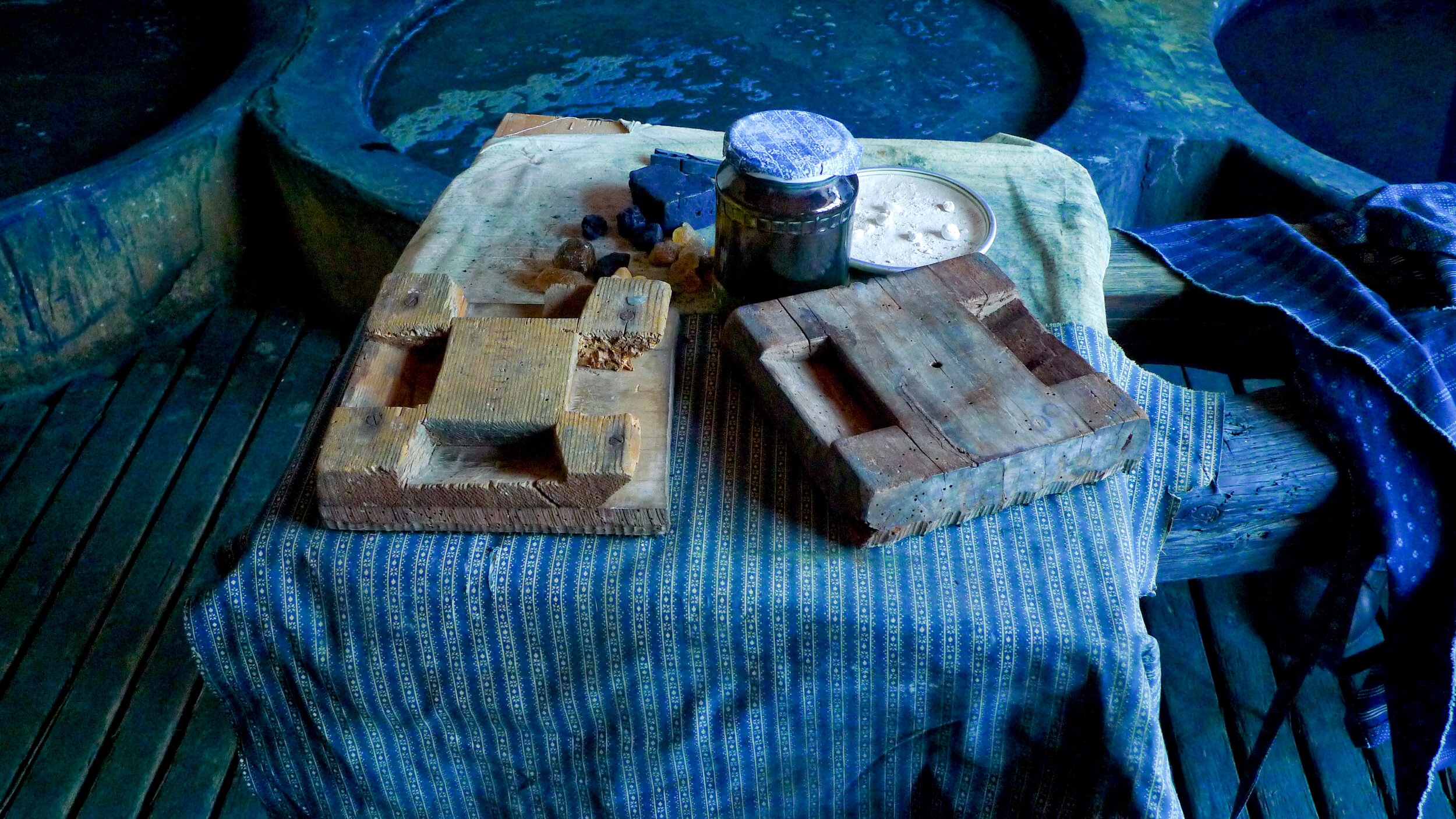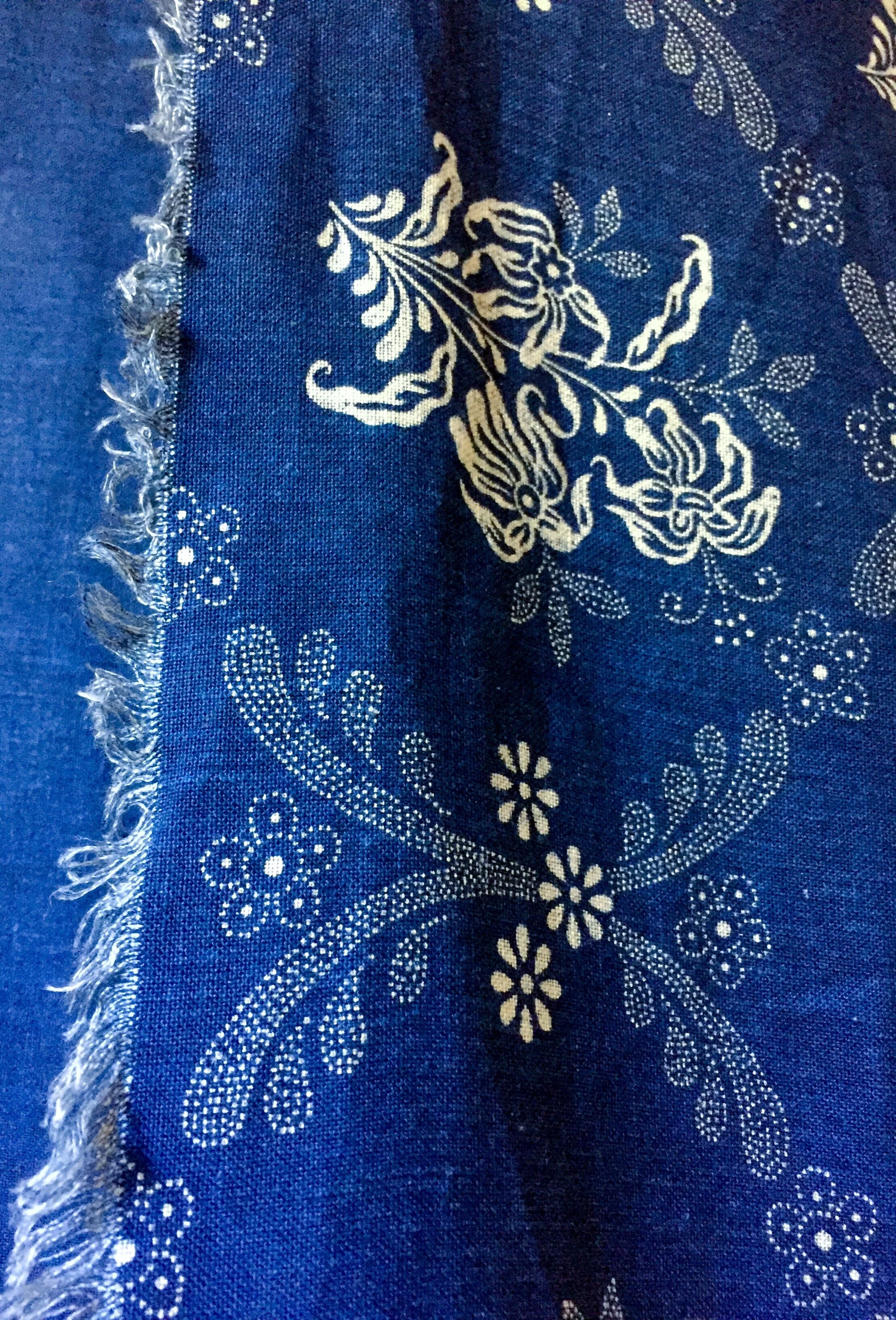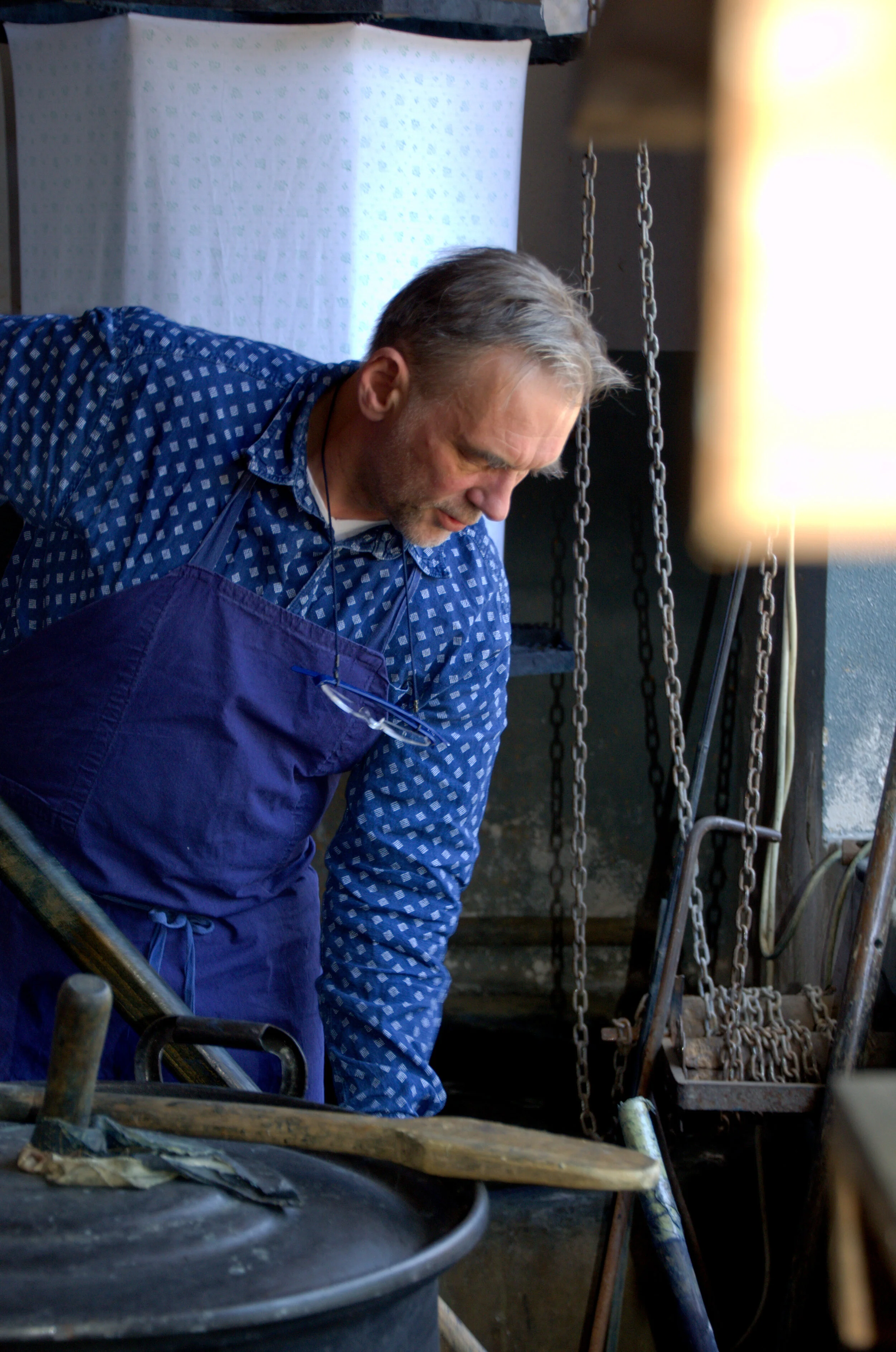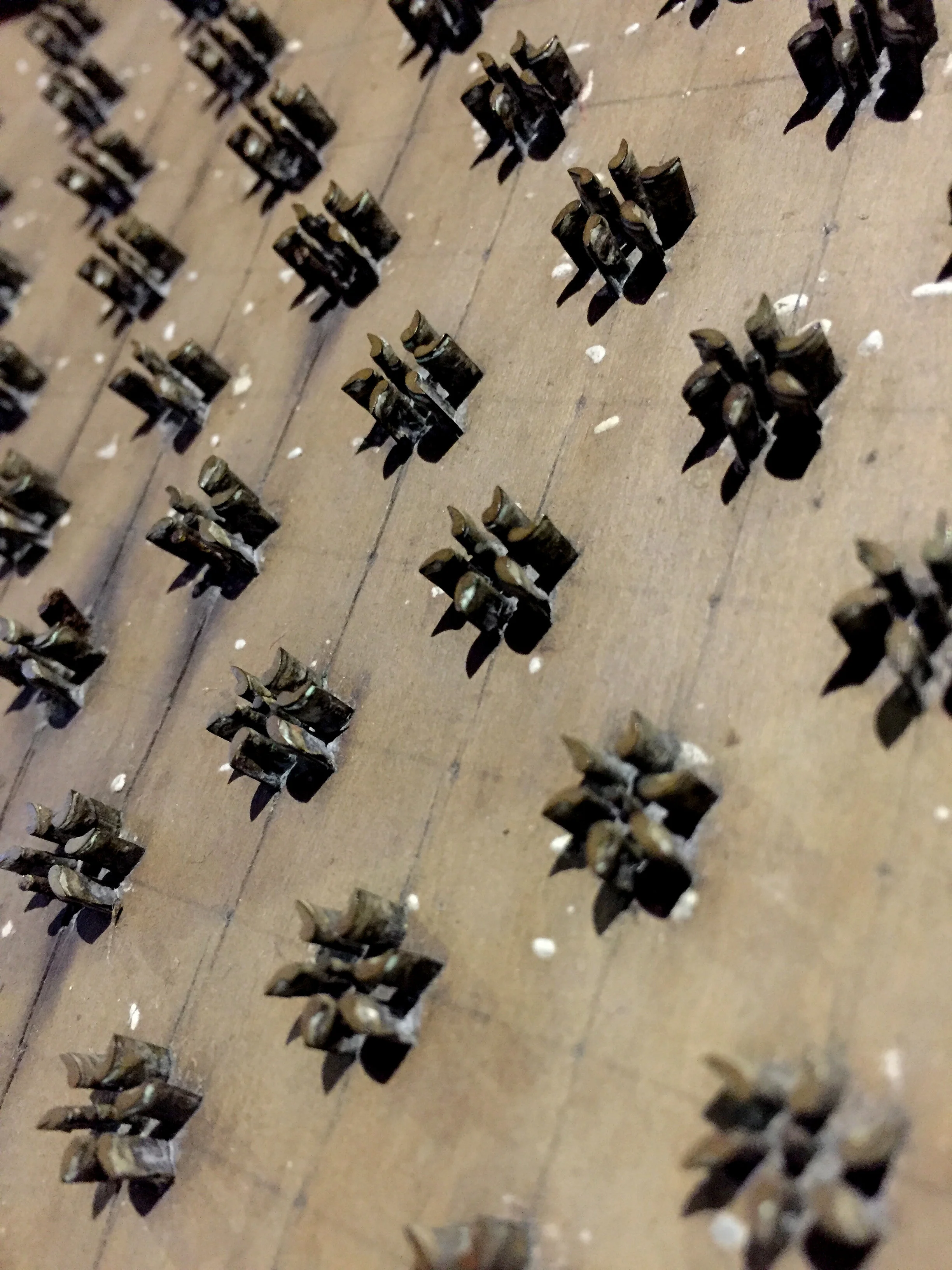Blueprint - Resist Block Printing and Indigo Dyeing in Europe
With over 6000 years of history, indigo extraction and indigo vat dyeing are among the earliest cultural biotechnological processes in practice. Indigo is the only natural dye that can produce a permanent blue on textile materials and its distinctive blue has always fascinated and inspired artists and artisans from all over the world.
Resist dyeing is one of the popular dyeing methods worldwide which includes a variety of techniques for creating patterns on textile materials by selectively colouring areas of a yarn or fabric. Resist dyeing techniques and patterns have developed a distinctive aesthetic appearance in different cultural regions. In Central Europe, it was blueprint that embedded the development of a locally and globally recognised design language.
Blueprint fabric with regionally-inspired floral designs from Upper Austria. Photo by Karin Altmann
Joseph Koó, one of the two last remaining blueprint practitioners in Austria. Photo by Karin Altmann
As a craft process that prints a resist paste onto the fabric before dyeing it with indigo, blueprint eludes the form of industrial production. The term ‘blueprint’ can be misleading because blueprint fabrics are not printed blue but dyed blue. The resist paste prevents the fabric from colouring in the indigo vat. After washing out the paste, a white pattern remains against the blue background.
The ingredients of the greenish resist paste, ‘Papp’, are well-kept secrets of every blueprint practitioner. There are hardly any written records and the recipes are usually passed on from one generation to the next. But the main components of the resist paste are gum arabic and clay.
Dye-resist paste called ‘Papp’ in German. Photo by Karin Altmann
Photo by Karin Altmann
Patterns seen in blueprints are mainly regionally-inspired designs of local flora and fauna. To apply them on to the cloth, European practitioners still use handcrafted wooden blocks, either made from carved pear or linden wood, or set with brass pins or strips.
Handcrafted wooden blocks. Photo by Karin Altmann.
Photo by Karin Altmann.
Printed fabrics must dry for at least three weeks before they can be dyed. Depending on the desired intensity of blue, the dyeing process can take up to 4 hours and requires up to 9 or more dips into the indigo vat. The fabrics are usually hung on small iron hooks in a star tire. The small holes along the fabric edges resulted from hanging are therefore a unique characteristic of traditional blueprint textiles.
Fabrics are usually hung on small iron hooks in a star tire.
Immersing the fabrics in the indigo vat: with every dip in the indigo vat, the colour can be built up from a light to a very deep, dark blue.
When textiles are removed from the indigo vat and absorb oxygen from the air, their colour change from yellow to green to blue.
‘Indigo flower’, which refers to the iridescent purplish blue foam floating on the surface of the indigo vat.
In the temperate zones of Europe, woad (Isatis tinctoria L.) was the main source until ‘Indian indigo’ (Indigofera tinctoria L.) reached the European markets. Woad has a relatively lower concentration of indigo. In the first half of the 17th century, several socio-economic development factors resulted in indigenous woad having to compete strongly with imported indigo: the growing indigo production in India paired with an industrialisation-driven demand in Europe fuelled large-scale exports from India and Europe’s transatlantic colonies and contributed to a complex and horrific chronicle of slavery and exploitation. By the end of the 17th century, woad was almost completely replaced. With the synthesis of indigo by German chemist Adolf von Baeyer and the beginning of commercial production in 1897, both woad and global natural indigo cultivation collapsed. Today, most European practitioners use imported natural indigo or sometimes synthetic indigo. In recent years, however, efforts have been made to rediscover and reuse woad for protecting and passing on the knowledge of local natural dyes.
The blueprint technique itself was established in Central Europe in the 17th century. During the 18th and 19th centuries, artisans and craftspeople used to travel abroad during their journey years, the so-called ‘Walz’. They learned blueprint techniques, documented their routes in travel books, formed guilds, and exchanged patterns with other practitioners.
Woad (Isatis tinctoria L.)
Detail from the travel book by Josef Zötl, from the Dyer's Museum Gutau, Austria.
Today, across Central Europe there are only a few blueprint workshops left, mainly as family businesses run by the second to seventh generations. They still use wooden blocks that are up to 300 years old and pass on their knowledge through observation and hands-on practices.
Although as a distinctive tradition in Europe, blueprint has experienced a rapid decline of practitioners in recent decades. More and more blueprinters are now trying to find a successor for their business and seek alternative ways to share their knowledge beyond passing from generation to generation within the family. They have nevertheless developed a sense of strong identity within the blueprinter community and feel united by a ‘passion for blue’.
To prevent the craft’s gradual disappearance, a multinational proposal was submitted by Austria, Czechia, Germany, Hungary and Slovakia to nominate European resist block printing and indigo dyeing as UNESCO Intangible Cultural Heritage of Humanity, which was approved as such in November 2018. The fact that this was a joint nomination of five countries underlines the importance of the preservation of indigo dyeing and blueprinting as a common craft and cultural heritage.
Read more about the indigo dyeing cultures and practices from the Higeta Indigo House in Japan, Living Blue in Bangladesh, and Hmong indigo batik in Pa Co Vietnam, Luang Prabang, Laos.
















